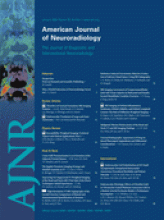Abstract
BACKGROUND AND PURPOSE: Reliability of CT perfusion (CTP) algorithms has not been fully validated. We investigated whether the cerebral blood flow (CBF) values obtained by using a dynamic CTP technique with a tracer delay–insensitive deconvolution algorithm are more accurate than those obtained by using CTP with delay-sensitive algorithms in unilateral cerebrovascular steno-occlusive disease, when compared with those generated by quantitative single-photon emission CT (SPECT).
MATERIALS AND METHODS: Using CTP and iodine-123-N-isopropyl-p-iodoamphetamine SPECT with an autoradiographic quantification technique, we examined 20 patients with suggested hemodynamic ischemia due to stenosis or occlusion of the unilateral internal carotid or middle cerebral artery. The algorithms used for CTP included delay-insensitive block-circulant singular value decomposition (SVD) (bSVD) and delay-sensitive standard SVD (sSVD) and box-modulation transfer function (bMTF).
RESULTS: Absolute CBF values obtained by using CTP with bSVD were significantly lower than those obtained with SPECT, but the ratios to the nonaffected side were significantly correlated to the quantitative SPECT values with significant agreements, particularly when the arterial input function was obtained from the unaffected side. Contrastingly, CBF ratios with sSVD and bMTF were significantly underestimated, and no significant agreement was determined between CTP with sSVD or bMTF and SPECT, though there were substantial correlations between them in some parameters.
CONCLUSIONS: With the CTP technique, the insensitivity of the deconvolution algorithm to the tracer-delay effect appears to be essential for estimating semiquantitative CBF values in patients with unilateral steno-occlusive lesions.
- Copyright © American Society of Neuroradiology












